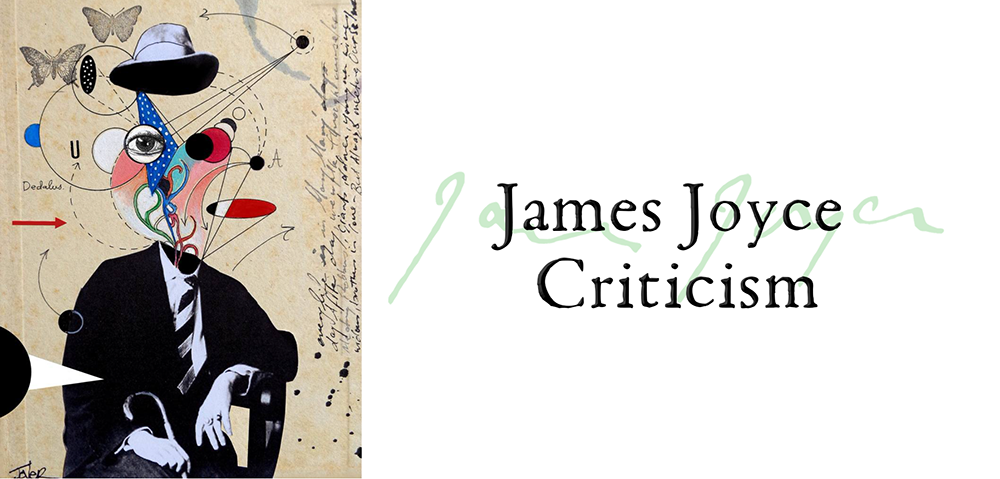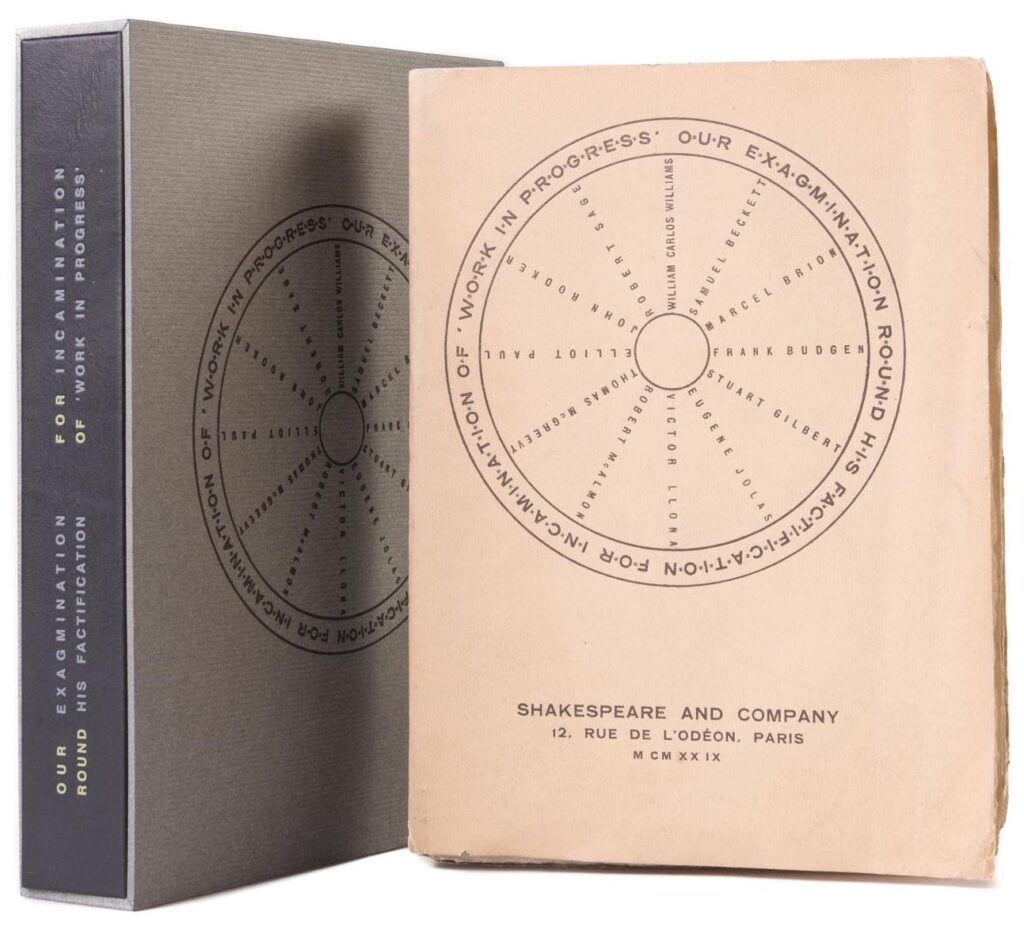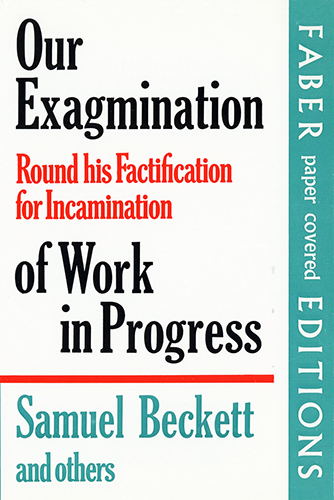Joyce Criticism: “Finnegans Wake” 2. Criticism 1929-1999
- At January 06, 2022
- By Great Quail
- In Joyce
 0
0
Finnegans Wake: Criticism 1929–1999
The works profiled below are literary criticism generally intended for advanced readers; beginner’s guides and annotations are described under their own section. The books are listed by publication date. Clicking a cover image takes you to Amazon.com. When Brazen Head commentary is unavailable, the publisher’s summaries are usually reprinted. If any knowledgeable Joyce reader would like to review, summarize, or provide additional information for any of these “uncommented” books, please drop us a line! Additional Wake criticism may be found by clicking the links below:
Finnegans Wake Criticism
[Main Page | Guides & Annotations | Criticism 1929-1999 | Criticism 2000-Present | About the Wake | Independent]
A Symposium: Our Exagmination Round his Factification for Incamination of Work in Progress
A Symposium: Our Exagmination Round his Factification for Incamination of Work in Progress
By Samuel Beckett, Stuart Gilbert, William Carlos Williams & Others
First Edition: Shakespeare & Company, 1929
A Symposium: Our Exagmination Round his Factification for Incamination of Work in Progress
By Samuel Beckett, Stuart Gilbert, William Carlos Williams & Others
Faber and Faber, 1972
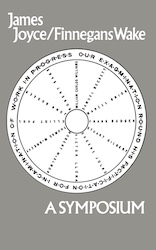
James Joyce/Finnegans Wake: A Symposium
By Samuel Beckett, Stuart Gilbert, William Carlos Williams & Others
Most Recent Edition: New Directions, 1972
Available online at: Internet Archive | PDF
No one knew exactly what the hell Joyce was writing after Ulysses, and he remained somewhat secretive about his new novel, calling it only “Work in Progress.” The few glimpses he would allow took the form of fragments published in the transition journal, or an occasional excerpt published by Faber and Faber. Of course, these odd bits of writing caused quite a stir, and it wasn’t long until some people thought that perhaps Mr. Joyce had lost his mind. Our Exagmination was a collection of supportive essays regarding these works, written by Joyce’s friends, fellow authors, and sympathetic critics. (Samuel Beckett is one.) As such they represent less an analysis of Finnegans Wake than a defense of Joyce’s revolutionary technique; the first real analysis of the Wake as a completed work would have to wait until Joseph Campbell published Skeleton Key in 1944.
Contents:
- Samuel Beckett, “Dante… Bruno. Vico.. Joyce”
- Marcel Brion, “The Idea of Time in the Work of James Joyce”
- Frank Budgen, “James Joyce’s Work in Progress and Old Norse Poetry”
- Stuart Gilbert, “Prolegomena to Work in Progress”
- Eugene Jolas, “The Revolution of Language and James Joyce”
- Victor Llona, “I Dont Know What to Call It but Its Mighty Unlikely Prose”
- Robert McAlmon, “Mr. Joyce Directs an Irish Word Ballet”
- Thomas MacGreevy, “The Catholic Element in Work in Progress”
- Elliot Paul, “Mr. Joyce’s Treatment of Plot”
- John Rodker, “Joyce and His Dynamic”
- Robert Sage, “Before Ulysses—and After”
- William Carlos Williams, “A Point for American Criticism”
Additionally, the “Symposium” cheerfully includes two “letters of protest.”
- G.V.L. Slingsby, “Writes a Common Reader”
- Vladimir Dixon, “A Litter to James Joyce”
Slingsby’s letter is genuine, and was written by a woman who complained to Sylvia Beach about the difficulty of “Work In Progress.” The name is a pseudonym borrowed from an Edward Lear story. The identity of Vladimir Dixon is more controversial. For many years, people thought it a pseudonym for Joyce himself, engaging in a little playful fun—what we’d call “sock puppeting” today. The letter is written in a pastiche mocking Joyce, whom Dixon refers to as “Shame’s Voice.” Although Sylvia Beach, Stuart Gilbert, and Richard Ellmann assumed the letter was Joyce’s, in 1979 Thomas Goldwasser published a refutation in the James Joyce Quarterly. According to Goldwasser, Vladimir Dixon was a Russian poet living in France, an American citizen who generally wrote in the Russian language.
Third Census of Finnegans Wake: An Index of the Characters and Their Roles
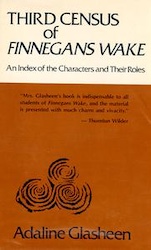
Third Census of Finnegans Wake: An Index of the Characters and Their Roles
By Adaline Glasheen
First Census: Northwestern University Press, 1956
Second Census: Northwestern University Press, 1963
Third Census: University of California Press, 1977
Available Online at: Internet Archive
In 1956 Adaline Glasheen published A Census of Finnegans Wake, an alphabetical index of the many mythical, historical, and fictitious figures found in the Wake, with biographical notes and cross references to the various mutated alterations of their names. Glasheen continued to refine her work over the next twenty years, publishing the Third Census of Finnegans Wake in 1977. (And even then she was unable to resolve some of her famous “asterisks,” as she described with characteristic honesty and bluntness: “An asterisk means I don’t know who somebody is.”) Edward Burns of the FW-List supplied this commentary:
The first census, A Census of Finnegans Wake: An Index of the Characters and Their Roles was published by Northwestern UP in 1956. Faber and Faber in London published the book in 1957 with a laid in sheet of corrections (not all the corrections Glasheen had submitted were published)—the pages from Northwestern were not corrected. Glasheen’s introduction tells how she began to make her lists—beginning in 1950-51. Almost immediately after its publication readers of the Wake began communicating with Glasheen offering her corrections and new identifications. Northwestern was not willing to do a new edition because the initial run had not been sold out. Through the efforts of Richard Ellmann, the journal The Analyst (a mimeographed journal published several times a year by the English Department of Northwestern University) published “Out of My Census” as its April 1959 issue (No. XVII, 1-73; all but one half page of the issue). Glasheen concludes this appendage to A Census by identifying her “donors”: Clive Hart, Fred Higginson, Fritz Senn, Gerard O’Flaherty, George Painter, James S. Atherton, J. Mitchell Morse, Matthew Hodgart, Mabel Worthington, Richard Ellmann, Ruth von Phul, Thornton Wilder, and Father William T. Noon, S. J. This publication result in more additions and corrections—indeed by this time Glasheen was in constant written communication with the Joyce scholars listed as well as dozens of others—including Hugh Kenner.
A Second Census revised and expanded from the first Census was published by Northwestern UP in 1963. It is this edition which many people feel is still the definitive one, in part, perhaps, because it was edited in exemplary fashion by Fritz Senn. Following its publication Glasheen continued to develop her own ideas and exchange ideas with other scholars. Although Northwestern agreed to publish a third edition of the Census, a crisis that threatened to close the press released her from her letter of understanding with them. J. Mitchell Morse made overtures to Temple University Press on her behalf, but she finally settled on the University of California Press at the urging of Hugh Kenner. This edition was published by 1977. This Third Census contains much revised material and many new identifications. There are numerous scholars who feel it is less accurate than the Second Census (Glasheen and her husband proof-read the Third Census which was newly set). As the editor of the Wilder-Glasheen Letters on Finnegans Wake (1950-1975), it is my hope that the publisher of that volume will agree to republish the Third Census (corrected) as it represents Glasheen’s final thoughts on many issues including her view of Shakespeare’s influence on the Wake. For an excellent article on the Census I suggest Bonnie Kime Scott’s, “A Consensus on Glasheen’s Census” in Re-Viewing Classics of Joyce Criticism.
The Books at the Wake: A Study of Literary Allusions in James Joyce’s Finnegans Wake
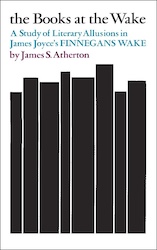
The Books at the Wake: A Study of Literary Allusions in James Joyce’s Finnegans Wake
By James S. Atherton
Viking, 1960
Available online at: Internet Archive
A comprehensive list of literary allusions found in the Wake. Bob Williams has this to say about it: “Atherton is a great neglected source. Little is said of his Books at the Wake but this is a small book packed with enough information and insight to power the average Finnegans Wake reader for the balance of his or her career.”
Structure and Motif in Finnegans Wake
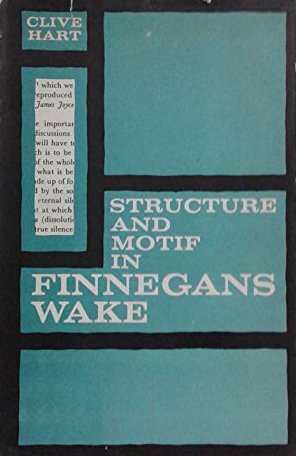
Structure and Motif in Finnegans Wake
By Clive Hart
Northwestern University Press, 1962
Available online at: Internet Archive
One of the first “modern” criticisms of the Wake, Structure and Motif outlines the mechanics of the book rather than providing an exegesis—although it does put forth that the time is certainly ripe for such a study.
A Concordance to Finnegans Wake
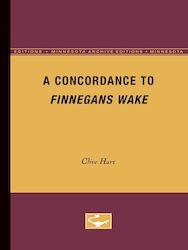
A Concordance to Finnegans Wake
By Clive Hart
University of Minnesota Press, 1963
Available Online at: Internet Archive
An early attempt to track the Wake’s allusions and break down some of Joyce’s compound puns, Hart’s Concordance was compiled over six years of “more or less harmless drudgery.” It’s essentially a 500-page index of all the words in Finnegans Wake, including the English stems of invented words and various meaningful syllables. Hart summarizes the project in his introduction:
This concordance should help the reader to trace the symbolic and thematic development of the intertwining verbal motifs out of which the book is constructed. It is divided into three main parts which provide page/line references for (1) all the words Joyce uses in the book: the “Primary Index”; (2) most of the words and important syllables contained in compounds: the “Syllabifications”; (3) the English words suggested by Joyce’s puns, distortions, etc.: the “Overtones.”
While modern technology has made the Concordance somewhat obsolete in form, if not function, Hart’s work was a seminal piece of early Wake scholarship, and helped support many subsequent studies.
A Lexicon of the German in Finnegans Wake
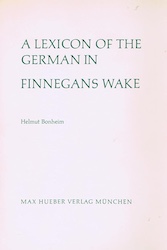
A Lexicon of the German in Finnegans Wake
By Helmut Bonheim
University of California Press, 1967
Available online at: University of Wisconsin-Madison
Publisher’s Description: It is generally agreed that we cannot have too much precritical; material at this stage in our excavations of that strange and complex work Finnegans Wake, first published twenty-eight years ago. Joyce himself labored for seventeen years on its composition, and scholars and Joyce enthusiasts have labored for twice that span to explore its many-layered meanings. Campbell and Robinson’s Skeleton Key, Mrs. Glasheen’s index to the characters, S. Atherton’s guide to the books that play some part in Finnegans Wake, and Clive Hart’s excellent concordance are available to guide the thoughtful reader, and now Mr. Bonheim provides us with the first in a series of truly basic tools for our excavations: a set of guides to the main foreign languages from which Joyce borrowed pieces for the construction of his curious edifice. Although a number of word lists of this nature have appeared recently—notably in the Wake Newslitter—no more than a few dozen words are considered in each instance. The present volume, however, represents a full-scale guide to one of the major languages used in the Wake—a language Joyce spoke fluently and used freely at every stage of composition. The Lexicon illuminates not only the manifold ways in which Joyce used German, but also reveals once more the resourceful wit with which Joyce explores and extends the limits of his native tongue. New light is thrown on the very nature of the formations which are made peculiarly possible by the English and the German languages. An unsuspected strangeness and charm in the language we use every day is revealed by Joyce’s stretching of word and idiom into new and foreign shapes. The arrangement of the more than 6,000 entries in the Lexicon has been carefully designed for maximum convenience to the reader, and has already served as model for several other forthcoming lexica of foreign languages in Finnegans Wake.
A Gaelic Lexicon for Finnegans Wake and Glossary for Joyce’s Other Works
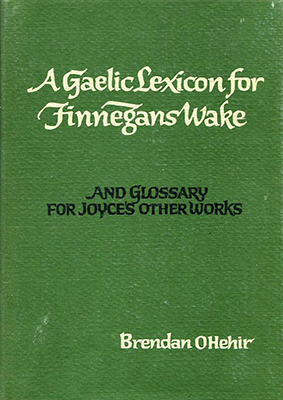
A Gaelic Lexicon for Finnegans Wake and Glossary for Joyce’s Other Works
By Brendan O Hehir
University of California Press, 1967
Available online at: Internet Archive | University of Wisconsin-Madison
Publisher’s Description: Finnegans Wake is a bafflingly complex work, into which its author poured everything he knew. Even before its final publication as a book, in 1939, readers of Finnegans Wake were looking for clues to guide them through its mazes. Since all the languages in the book, including the Gaelic, are masked and twisted, the ear is often a better interpreter than the eye in understanding the convolutions of the language. Thus an ear that is attuned to the sounds, cadences, vocabulary, and syntax of Gaelic can determine, for example, that the phrase “Dorsan from Dunshanagan” is actually “Grasshopper from Ant’s Fort” (Dorsán from Dún Seangáin). Mr. O Hehir has that kind of ear. Combining rare proficiency in Gaelic with equal proficiency in Joyce, he identifies and interprets all the Gaelicisms that Joyce used, and arranges them in the same simple and logical format employed in Helmut Bonheim’s Lexicon of German in Finnegans Wake (California, 1967). Irish words and phrases are listed successively as they occur, according to the conventional page and line numbering established by Clive Hart’s Concordance. The entries are arranged in three columns. In column one, the Irish or Irish-derived word or phrase is identified beside its page and line number. In column two, the conventional Irish spelling of the original is given, along with a simplified phonetic approximation of the pronunciation. In the third column, the word or phrase is translated into English, with explanatory notes as required. Although Joyce’s use of Irish is by no means always so straightforward as this arrangement suggests, anomalies are adapted to this pattern as conveniently and economically as possible. The main glossary is augmented by “Supplementary Notes,” which take up certain matters that occur frequently in the book, such as variations on the Irish names for Dublin.
In 1970, A.M.L. Knuth reviewed O Hehir’s book in Neophilologus:
The greater part of his book is devoted to Finnegans Wake, but it also contains a glossary for the other works. For instance, about fifteen pages are given to Irish words and expressions occurring in Ulysses. In the last section we find a number of “Supplementary Notes”, which will be highly appreciated by the student of Finnegans Wake. Some of these notes had been published earlier in A Wake Newslitter and the James Joyce Quarterly, but the majority are new. As for the glossary itself, O Hehir presents it in three columns; in the first he gives the words in the form and sequence in which they appear in Finnegans Wake and the other works, in the second the official Gaelic spelling with a phonetic approximation in round brackets, and in the third column the meaning in English, and, in the case of proper names, the etymology. He refrains from comment; he gives no interpretation of the function of the Irish components,—except in the “Supplementary Notes”.
Vico’s Doctrine of Ricorso in James Joyce’s Finnegans Wake
Vico’s Doctrine of Ricorso in James Joyce’s Finnegans Wake
By Donna Henseler
Ann Arbor: University Microfilms, 1974
An unpublished doctoral dissertation that’s nearly impossible to find, Dean Cauley says this of Henseler’s work: “This work is refreshingly readable, and Ms. Henseler shows a deep and comprehensive understanding of both Finnegans Wake and The New Science. This work, unlike efforts of Beckett, Tindall and some others, clearly shows the function of ricorso in Finnegans Wake. Her explanation cast a whole new light on Book III, and on the episodes of Thunder. Having read many popular interpretations, I was pleased to gain a whole new perspective from reading this work. I found myself reading with Henseler’s book in one hand, Finnegans Wake in the other, while scribbling down notes—the truly rewarding experience of gaining fresh insight. I would highly recommend this dissertation to any fan of the Wake.”
A Conceptual Guide to Finnegans Wake
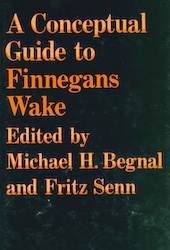
A Conceptual Guide to Finnegans Wake
Edited by Michael H. Begnal & Fritz Senn
Penn State University Press, 1974
Available Online at: Internet Archive
This early book of Wake criticism collects thirteen essays organized sequentially by chapter.
Contents:
- Michael Begnal: Introduction
- J. Mitchell Morse, “Where the Terms Begin” / Book I, chapter i
- Roland McHugh, “Recipis for the Price of the Coffin” / Book I, chapters ii-iv
- Bernard Benstock, “Concerning Lost Historeve” / Book I, chapter v
- Edmund L. Epstein, “The Turning Point” / Book I, chapter vi
- Robert Boyle, “Portrait of the Artists as a Balzacian Wilde Ass” / Book I, chapters vii-viii
- Matthew Hodgart, “Music and the Mime of Mick, Nick, and the Maggies” / Book II, chapter i
- Ronald E. Buckalew, “Night Lessons on Language” / Book II, chapter ii
- Edward A. Kopper, “‘but where he is eaten’: Earwicker’s Tavern Feast” / Book II, chapter iii
- Michael H. Begnal, “Love that Dares to Speak its Name” / Book II, chapter iv
- James A. Atherton, “Shaun A” / Book III, chapter i
- Hugh B. Staples, “Growing Up Absurd In Dublin” / Book III, chapters ii-iii
- Margaret Solomon, “The Porters: A Square Performance of Three Tiers in the Round” / Book III, chapter iv
- Grace Eckley, “Looking Forward to a Brightening Day” / Book IV, chapter i’
Narrator and Character in Finnegans Wake
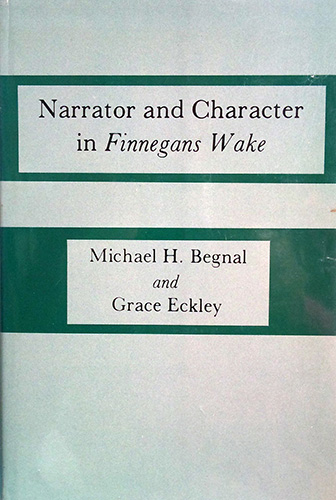
Narrator and Character in Finnegans Wake
By Michael H. Begnal & Grace Eckley
Bucknell University Press, 1975
Charles Cave: In this study are combined two very different points of view on James Joyce’s final masterpiece, Finnegans Wake. As Bernard Benstock points out in his foreword to the book, each of the two authors employs their own critical tools; Michael Begnal works towards encompassing the Wake as a novel, whereas Grace Eckley’s approach is in terms of the individual word or phrase. Their monographs combine nicely here to cast new and different lights on Finnegans Wake. Despite their divergences, however, both authors document specifically from the book’s text.
For Begnal (Part One: “The Dream Voices of Finnegans Wake”), Benstock writes that the method of the novels’ presentation “is contained in its narration, in the succession and diversity of the narrative voices that undertake the piecemeal unfolding of the cumulative drama.” The basic point of Begnal’s section of the book may be said to be his refutation of the single-dreamer theory of interpretation of Finnegans Wake. As he discusses their roles in the novel, he attempts to identify the multiple dreamers and their stylistic characteristics.
For Eckley (Part Two: “Queer Mrs Quickenough and Odd Miss Doddpebble”), says Benstock, “Finnegans Wake is a document in folk literature; its antecedents are to be found in the wealth of Irish folklore and throughout world mythology. Her view of the book is centered upon its thematic development with tree-and-stone utilised as guidelines (touchstones and touchtrees).” Eckley considers the Anna Livia Plurabelle chapter as central to Finnegans Wake. In it is presented a dialogue between two washerwomen who, at the end of the chapter, are transformed into a tree and a stone. Throughout, these washerwomen can be distinguised by characteristics that apply to Shem and Shaun, in the basic contention of tree and stone, wherever they appear and whatever their names have been changed to. This view contradicts the previously established “mergence of identity” theory of Finnegans Wake, which held, in brief, that Shem and Shaun occasionally merge into a third character.
The Decentered Universe of Finnegans Wake: A Structural Analysis
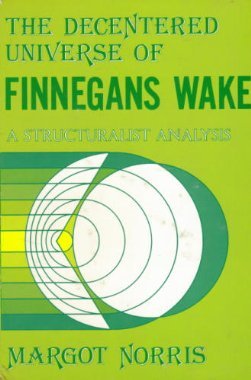
The Decentered Universe of Finnegans Wake: A Structural Analysis
By Margot Norris
The Johns Hopkins University Press, 1976
Available online at: Internet Archive
Publisher’s Description: The pioneer critics of Finnegans Wake hailed the work as a radical critique of language and civilization. Resuming their position, Margot Norris explains the book’s most intractable uncertainties not as puzzles to be solved by a clever reader but as manifestations of a “chaosmos,” a Freudian dream world of sexual transgression and social dissolution, of inauthentic being and empty words. Conventional moralities and restraints are under siege in this chaosmos, where precisely those desires and forbidden wishes that are barred in waking thought strive to make themselves felt. Norris demonstrates convincingly that the protean characters of Finnegans Wake are the creatures of a dreaming mind. The teleology of their universe is freedom, and in the enduring struggle between the individual’s anarchic psyche and the laws that make civilization possible, it is only in dream that the psyche is triumphant. It is as dream rather than as novel that Norris reads Finnegans Wake. The lexical deviance and semantic density of the book, Norris argues, are not due to Joyce’s malice, mischief, or megalomania but are essential and intrinsic to his concern to portray man’s inner state of being. Because meanings are dislocated—hidden in unexpected places, multiplied and split, given over to ambiguity, plurality, and uncertainty—the Wake, Norris claims, represents a decentered universe. Its formal elements of plot, character, discourse, and language are not anchored to any single point of reference; they do not refer back to center. Only by abandoning conventional frames of reference can readers allow the work to disclose its own meanings, which are lodged in the differences and similarities of its multitudinous elements. Eschewing the close explication of much Wake criticism, the author provides a conceptual framework for the work’s large structures with the help of theories and methods borrowed from Freud, Heidegger, Lacan, Levi-Strauss, and Derrida. Looking at the work without novelistic expectations of the illusion of some “key” to unlock the mystery, Norris explores Joyce’s rationale for committing his last human panorama—a bit sadder than Ulysses in its concern with aging, killing, and dying—to a form and language belonging to the deconstructive forces of the twentieth century.
The Sigla of Finnegans Wake

The Sigla of Finnegans Wake
By Roland McHugh
University Texas Press, 1976
Available online at: Internet Archive | University of Wisconsin-Madison
In 1967, two important new works of Wake scholarship were published that offered contradicting views. While Margot Norris argued for a “decentered universe,” Roland McHugh saw the Wake as more tightly structured. In 1978, Shari Benstock reviewed McHugh’s book in the Journal of Beckett Studies:
Roland McHugh notes in The Sigla of Finnegans Wake that much of the criticism in these years progressed little beyond the initial work of the Campbell-Robinson Skeleton Key, and he argues that “unfortunately, much published exegesis exhibits a depressing indifference to context and continuity, which results from the disproportionate acquaintance with the text possessed by most exegetes”. Insisting that any exegesis must be able to account for the position of any unit in FW as a transition between the units on either side of it (what McHugh calls the ‘syntactic complex’) as well as account for the unit’s ‘contribution to the tone of the section’, he sets out to consider Joyce’s use of sigla, those marks which ‘appear in the author’s manuscripts and letters as abbreviations for certain characters or conceptual patterns underlying the book’s fabric’. Admonishing the reader to keep his well-marked copy of the Wake close at hand for ready reference, he sets out on his task, demonstrating first how the sigla themselves generated from Joyce’s rough notes to the final fourteen which make up the set examined by The Sigla. McHugh’s approach is traditional in that it acknowledges the existence of the basic family unit in the Wake and examines the roles of members of that family assuming that they are recognizable personages with distinctly marked personality quirks which remain, once established, fairly consistent.
A Classical Lexicon for Finnegans Wake: A Glossary of the Greek and Latin in the Major Works of Joyce
![]()
A Classical Lexicon for Finnegans Wake: A Glossary of the Greek and Latin in the Major Works of Joyce
By Brendon O Hehir and John Dillon
University of California Press, 1977
Available online at: Internet Archive | University of Wisconsin-Madison
Publisher’s Description: The language of James Joyce’s Finnegans Wake is a complex tissue or fusion of a host of natural languages. Helmut Bonheim’s A Lexicon of the German in Finnegans Wake (California, 1967) pioneered the process of disentangling a single major strand, to be followed by Mr. O Hehir’s A Gaelic Lexicon for Finnegans Wake (California, 1967). Now this much-needed Classical Lexicon takes its place beside its earlier companion volumes. It follows the same tri-columnar format, listing the words and phrases to be glossed in the first column, in the order of their occurrence in the text; the middle column rectifies the textual appearance into a normalized Latin or Greek spelling; and the third column provides the gloss in the form of a translation or explanatory note. Joyce’s books before Finnegans Wake are replete with Latin, and even the reader not yet ready to plunge into the darkness of the Wake will find both handy and illuminating the complete glossing of the Latin and Greek quotations and classical references throughout Joyce’s other works. About an eighth of the Classical Lexicon consists’ of glosses for the earlier books. In addition, three appendixes and a set of Supplementary Notes at the back of the volume contain no fewer than 116 brief explanatory essays expanding details of classical language, history, and culture which cannot be covered adequately in the main body of word-by-word glosses. The dedicated Wake scholars should reap a rich harvest from this Classical Lexicon, and the non-classically-trained reader of Joyce will find the book an invaluable companion, not only on forays into Finnegans Wake, but in reading all of Joyce’s works.
A Finnegans Wake Gazetteer
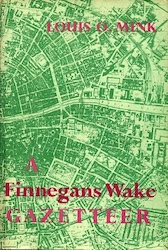
A Finnegans Wake Gazetteer
By Louis O. Mink
Bloomington: Indiana University Press, 1978
Available online at: Internet Archive
Publisher’s Description: A guide to the places and selected events in James Joyce’s Finnegans Wake. In the book, the boundaries of Dublin expand to include the rest of the globe, plus the imaginary locales of mythology and fiction.
Joyce’s Use of Colors: Finnegans Wake and the Earlier Works
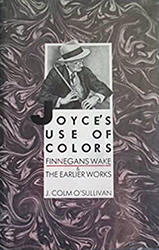
Joyce’s Use of Colors: Finnegans Wake and the Earlier Works
By J. Colm O’Sullivan
UMI Research Press, 1987
According to Karl Reisman of the F-WAKE List, this book “investigates the color patterns of Finnegans Wake, arguing that Joyce deliberately employed patterns of color association in structuring themes of his last great work. He argues further that the tracing of those patterns helps to clarify the themes and the manner of their articulation. Through a close analysis of Finnegans Wake, color words are identified and linkages between colors, characters, ideas, and themes are traced. O’Sullivan uses the framework of color patterns to enrich our reading of this most obscure and important modern literary work.”
Vico and Joyce
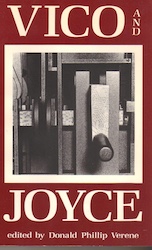
Vico and Joyce
By Donald Phillip Verene
State University of New York Press, 1987
Available online at: Internet Archive
From the Publisher: Joyce said, “My imagination grows when I read Vico as it doesn’t when I read Freud or Jung.” This volume is the first extended examination of the connections between Vico and Joyce. Joyce employed Vico’s New Science as the basis of Finnegans Wake, as he employed Homer’s Odyssey as the basis of Ulysses. In what ways are Vico and Joyce similar? To what extent is Vico an influence on Joyce? And in what ways can Vico’s philosophy be newly understood when seen in relation to Joyce’s use of it? This book suggests ways to see both thinkers anew. Vico and Joyce is divided into three major parts: “Cycles and History,” in which Vico’s famous conception of the course and recourse of historical events is examined in relation to Joyce’s use of this idea in Finnegans Wake; “Joyce and Vico,” in which the relationship between the two thinkers is approached more from the side of Joyce than Vico; “Language and Myth,” in which the similarities of Vico’s and Joyce’s grasp of language and imaginative forms of thought are considered.
Wandering and Return in Finnegans Wake: An Integrative Approach to Joyce’s Fictions
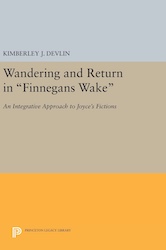
Wandering and Return in Finnegans Wake: An Integrative Approach to Joyce’s Fictions
By Kimberly J. Devlin
Princeton University Press, 1990
Publisher’s Description: Guiding readers through the disorienting dreamworld of James Joyce’s last work, Kimberly Devlin examines Finnegans Wake as an uncanny text, one that is both strange and familiar. In light of Freud’s description of the uncanny as a haunting awareness of earlier, repressed phases of the self, Devlin finds the uncanniness of the Wake rooted in Joyce’s rewritings of literary fictions from his earlier artistic periods. She demonstrates the notion of psychological return as she traces the obsessions, scenarios, and images from Joyce’s “waking” fictions that resurface in his final dreamtext in uncanny forms, transformed yet discernible, often to uncover hidden, unconscious truths. Drawing on psychoanalytic arguments and recent feminist theory, Devlin maps intertextual connections that reveal many of Joyce’s most deeply felt imaginative and intellectual concerns, such as the self in its decentered relationship to language, the elusive nature of human identity, the anxieties implicit in mortal selfhood, the male subject in its opposition to the female sexual “other.” She suggests that the Wake records Joyce’s implicit interest in the psychological counterpart to Vico’s theory of historical repetition: Freud’s theory of the insistent internal return of earlier narratives.
Joyce’s Waking Women
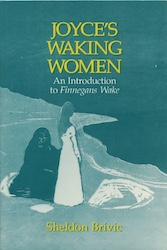
Joyce’s Waking Women
By Sheldon Brivic
University of Wisconsin Press, 1995
Sheldon Brivic is an English professor at Temple University. A lifelong Joycean, he’s written six books about Joyce, most of them examining his work through the psychological theories of Freud, Jung, and Lacan. Joyce’s Waking Women is a feminist “introduction” to Finnegans Wake. According to Book News, Brivic “aims to draw the reader quickly into the novel’s depths through detailed feminist and Lacanian reading of several crucial sections and themes. Includes a substantial introduction concerning Joyce’s attitudes toward women.”
Joyce’s Grand Operoar: Opera in Finnegans Wake
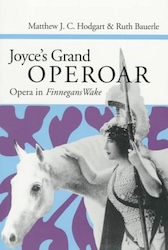
Joyce’s Grand Operoar: Opera in Finnegans Wake
By Matthew J. C. Hodgart & Ruth Bauerle
University of Illinois Press, 1996
Available online at: Internet Archive
A decorated veteran of World War II, Matthew John Caldwell Hodgart (1916-1996) was a British professor in the “eccentric” mold, known for a wide range of interests that included solving puzzles, collecting beach pebbles, and singing obscure English ballads. He was an expert in Volkswagen beetles, and wrote a “sequel” to Gulliver’s Travels that satirized political unrest on American campuses. Hodgart reputedly became familiar with Finnegans Wake by taking it to war, and is notable for being one of the first Joyce scholars to focus on Finnegans Wake rather than Ulysses. After publishing articles on Shakespeare, Vico, and foreign languages in the Wake, he turned his attention to music, a fascination that would produce two books. The first was Song in the Works of James Joyce, written with Temple University’s Mabel Worthington. The second was Joyce’s Grand Operoar: Opera In Finnegans Wake, written with Ruth Bauerle and published the year after his death. Hodgart also helped Roland McHugh with musical notes for McHugh’s Annotations to Finnegans Wake. (Ruth Bauerle published a heartfelt and informative obituary for Hodgart in the James Joyce Quarterly.)
Publisher’s Description: A passionate musician as well as a writer, James Joyce grew up hearing his father sing opera arias and for a time aspired to become a singer himself. The abundant allusions to opera throughout Joyce’s work reflect his immersion in this world. In Joyce’s Grand Operoar, two internationally respected Joyce scholars join forces to present over 3,000 of Joyce’s opera allusions as they appear in Finnegans Wake. Ruth Bauerle’s long, richly detailed, and often amusing introduction critically interprets Joyce’s life and work in terms of its operatic and literary interconnections. The resulting volume will delight both opera lovers and Joyceans. The allusions are organized first by the page and line of their appearance in Finnegans Wake and then cross-referenced by opera composers and their works, librettists, designers, critics, and conductors, as well as by arias, characters, and singers. The rich musical subtext of Finnegans Wake incorporates Joyce’s earlier opera allusions in a grand opera finale of his own.
The Adventure of the Detected Detective: Sherlock Holmes in James Joyce’s Finnegans Wake
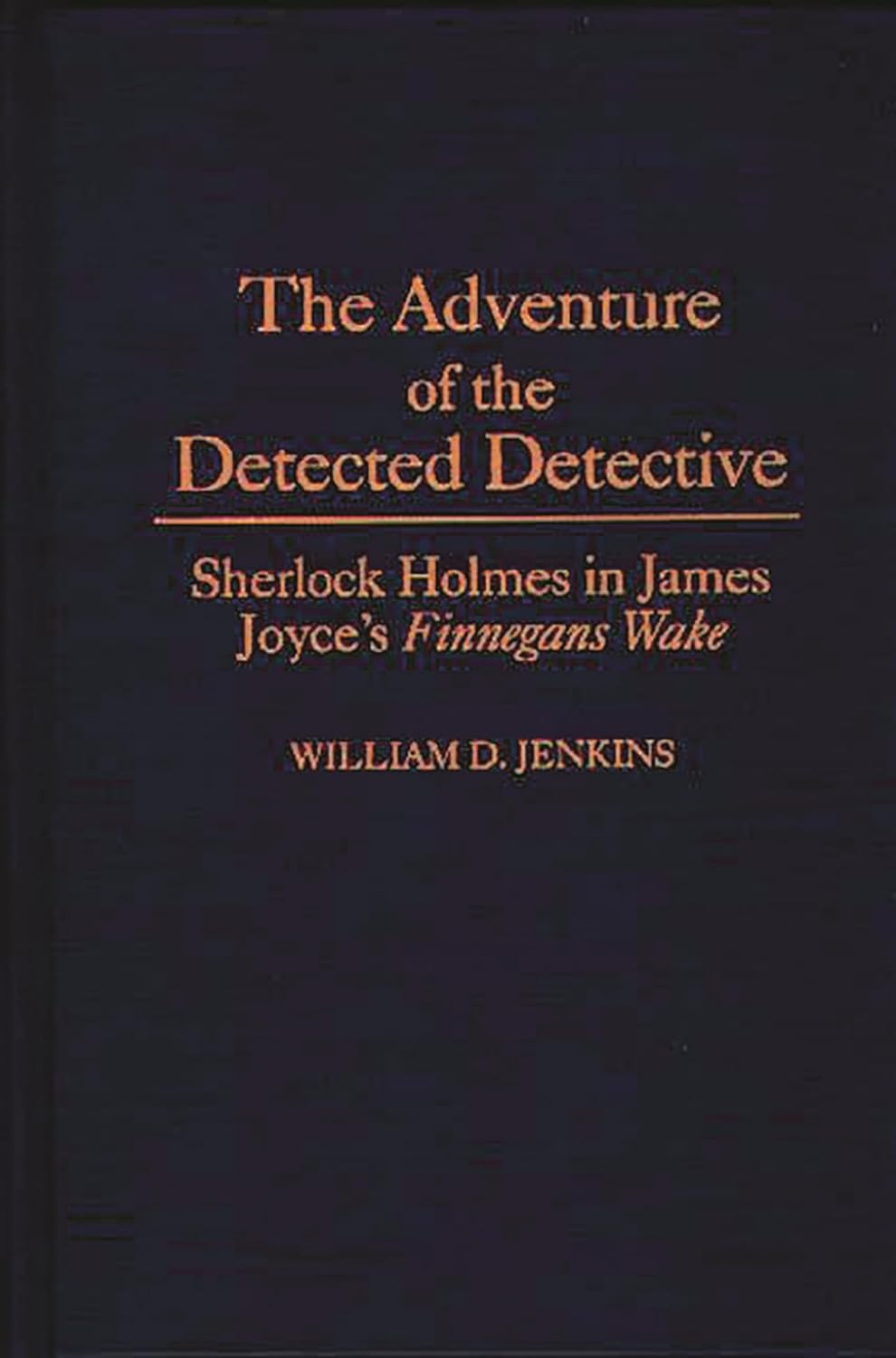
The Adventure of the Detected Detective: Sherlock Holmes in James Joyce’s Finnegans Wake
By William D. Jenkins
Greenwood, 1997
Publisher’s Description: What better introduction could there be to Finnegans Wake, perhaps the most difficult literary work ever written, than the Sherlock Holmes stories, perhaps the most readable and popular stories ever written? James Joyce made extensive use of Sherlockian material in his work; indeed, Jenkins argues, this use goes to the core of the meaning and structure of Finnegans Wake. In this exhaustive and entertaining analysis, Jenkins provides the specific references to Holmes’ adventures in the Wake and examines the context in which they occur and how they relate to the larger Wake themes.
The Role of Thunder in Finnegans Wake
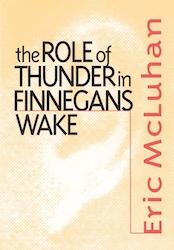
The Role of Thunder in Finnegans Wake
By Eric McLuhan
University of Toronto Press, 1997
Publisher’s Description: James Joyce’s use of ten one hundred-letter words in Finnegans Wake has always been an intriguing feature of that novel. Eric McLuhan takes a new by placing the Wake in the tradition of Menippean satire, where language is used to shock and provoke. Seen in this light, Joyce’s peculiar language and style become part of this Menippean tradition through his use of the linguistic “thunderclap.” The Role of Thunder in Finnegans Wake is the first book to examine this strangest and most prominent aspect of the language of the Wake, and explain its use in the context of classical Greek literature. Each thunderclap is a resonating logos that represents a transformation of human culture. McLuhan presents the thunders as encoding Joyce’s study of ten major communications revolutions, ranging from neolithic technologies such as speech and fire, through cities, the railroad, and print, to radio, movies, and television. Seen in this fashion, Finnegans Wake is both an encyclopedia of the effects of technology in reshaping human culture and society, and a complete training course for detecting the changes in sensibility occasioned by new media.
CONTINUE TO > Finnegans Wake Criticism 1999-Present
Joyce Criticism
[Main Page | General Criticism | Dubliners | Portrait | Ulysses | Finnegans Wake]
Authors: Allen B. Ruch, Charles Cave & Bob Williams
Artwork: Loui Jover
Last Modified: 14 June 2024
Main Joyce Page: The Brazen Head
Contact: quail(at)shipwrecklibrary(dot)com

